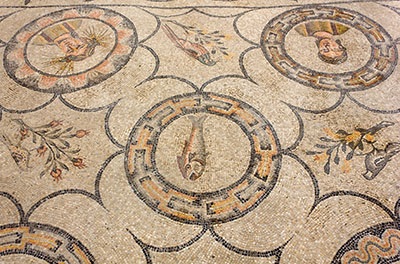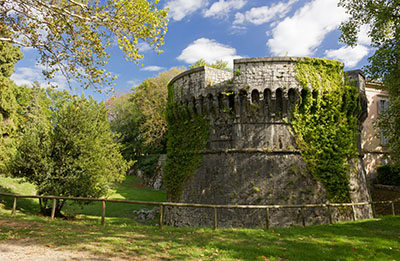Great History

A one-hundred-kilometer path will be enough to let us take a plunge into all historic periods: ancient, medieval, modern and contemporary. The first leg is the multifaced little town of Grado, whose importance as a seaside resort accompanies that of its numerous historical testimonies. The "calli" (alleys) and the "campielli" (little squares) of Grado vecchia (old town) throw us into a medieval atmosphere, which has its most important point in the Sant'Eufemia's early Christian Basilica, dating back to the Fifth Century and rich in late ancient mosaics and marble columns all different from each other. Few people know that between the year 607 up to 1451 Grado was a patriarchal seat before it being transferred to Venice. Adjacent to the Basilica we can visit the octagonal baptistery, the lapidary and another important early Christian basilica, that of Santa Maria delle Grazie, built applying the golden ratio.
The following leg is very near and is the first by importance of the whole itinerary: Aquileia, metropolis of the Roman world, that presents us with many treasure of its past, a glorious past in the Roman age, in late Antiquity (it was the main center of diffusion of the Christian religion over a very vast area) and in the early Middle Ages. The Basilica is, for a million reasons, of enormous importance: the main reason is perhaps the extraordinary Fourth Century floor mosaic, the largest in the whole western Christian world. The crypts too contains true art treasures of the ancient past, not to mention all those kept in the basilica itself. And the wonder doesn't end at the complex of the basilica, but continues in the museums (archeological, early Christian, of the Patriarchy) and in the numerous archeological sites scattered throughout the area.
The following leg is very near and is the first by importance of the whole itinerary: Aquileia, metropolis of the Roman world, that presents us with many treasure of its past, a glorious past in the Roman age, in late Antiquity (it was the main center of diffusion of the Christian religion over a very vast area) and in the early Middle Ages. The Basilica is, for a million reasons, of enormous importance: the main reason is perhaps the extraordinary Fourth Century floor mosaic, the largest in the whole western Christian world. The crypts too contains true art treasures of the ancient past, not to mention all those kept in the basilica itself. And the wonder doesn't end at the complex of the basilica, but continues in the museums (archeological, early Christian, of the Patriarchy) and in the numerous archeological sites scattered throughout the area.

We take a leap of more than a thousand years when we arrive at Palmanova, called "the star-shaped town" for its geometrically perfect nine-point-star polygonal structure, masterpiece of the Venetian military architecture, fortress city built for defense from the foreign threats and therefore surrounded by walls, moats, strongholds.
Gradisca d'Isonzo is also worth a brief visit, charming little town that belongs to the club gathering the most beautiful villages of Italy. Strolling through its streets, its well attended shady parks and under the strong towers of its walls, we can perceive a mood of "orderly liveliness", as if an ancient wisdom still permeated its sidewalks and its palaces, in a very successful union of human settlement and natural landscape.
And we can't but conclude our trip by visiting the symbol destination of the Great War, the Sacrario di Redipuglia (Redipuglia memorial), next to which less renowned but maybe more interesting and evocative places should be favoured: the adjacent Sant'Elia's hill, the perfect place for meditating and reflecting on the absurdity of war and of the "useless massacre" that the '14'-18 conflict was; in the end two museums: the "Casa III Armata" and the recently inaugurated Interactive Museum of the Great War, hosted in the former Fogliano's railway station.
Gradisca d'Isonzo is also worth a brief visit, charming little town that belongs to the club gathering the most beautiful villages of Italy. Strolling through its streets, its well attended shady parks and under the strong towers of its walls, we can perceive a mood of "orderly liveliness", as if an ancient wisdom still permeated its sidewalks and its palaces, in a very successful union of human settlement and natural landscape.
And we can't but conclude our trip by visiting the symbol destination of the Great War, the Sacrario di Redipuglia (Redipuglia memorial), next to which less renowned but maybe more interesting and evocative places should be favoured: the adjacent Sant'Elia's hill, the perfect place for meditating and reflecting on the absurdity of war and of the "useless massacre" that the '14'-18 conflict was; in the end two museums: the "Casa III Armata" and the recently inaugurated Interactive Museum of the Great War, hosted in the former Fogliano's railway station.
Grado - Aquileia - Palmanova - Gradisca - Redipuglia
Total duration: circa 8 hours, of which 2 hours circa of car transfers (around 100 kms)

